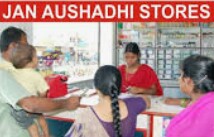The Jan Aushadhi Scheme (JAS) initiated by the Government of India is a powerful intervention against the unjustifiable pricing of medicines by private pharmaceutical industry, to make the generic medicines available at affordable prices. The marginalized populations of India are not able to afford many branded medicines; hence, there is an urgent need for making the cheaper generics available to Indians in the best interest of populations. It has been observed that lack of awareness in the public, distribution of free medicines by state governments, lack of support for JAS, poor supply chain, and doctors not prescribing generic medicines are the major constraints faced by the JAS leading to its poor success.
Launched in 2008 by the Department of Pharmaceuticals, the Jan Aushadhi Scheme (JAS) (Public Medicine Scheme) initiated by the Government of India. Bureau of Pharma Sector Undertakings (BPSU) of India, a special wing of Department of Pharmaceuticals, was entrusted the duty to govern the operation of JAS. The scheme was implemented to improve the quality of affordable health care in the nation. Under the Drug Price Control Order, 1995, National Pharmaceutical Pricing Authority controls the maximum retail prices of medicines and their formulations.The pharmaceutical industry of India produces quality generic medicines at reasonable prices. Hence, Indian generics find way to many countries.
The scheme enables substantial savings in healthcare expenditure, particularly for economically poor and patients suffering from chronic diseases. This scheme redefine the production, retail trade, and medicine prescription of doctors. The national list of essential medicines and the list of unbranded generic medicines have been developed by the GOI to enable the success and effectiveness of the program.
The implementation and execution of the program to improve the affordable and available generic medicines are planned through JAS and need to be done vigilantly to ensure that no fake or spurious medicines are supplied through JAS. The objective of the scheme is to make available low-priced quality medicines for all, thereby reducing the unit cost of treatment per person and thus improve their quality of life. The GOI intends to create awareness about the efficacy of the generic medicines, thereby stimulating the demand for these. It will encourage doctors to prescribe generic medicines. The BPSU is the implementing agency with the support of Central Pharma Public Sector Undertakings (CPSUs) and Jan Aushadhi to provide generic medicines.
Generic nomenclature is the chemical name of a drug. Pharmaceutical companies give the medicines a brand name for its dosage form, concentration, and patent such formulations.The companies advertise their brands to make them popular, influence the prescription behavior to increase the sale of own branded medicine, and once the brand is established, make money out of it by pricing their branded medicines exorbitantly. Compared to the branded version, its generic version is available at a lesser price. The BPSU focuses on marketing generic medicines in JAS by sourcing of medicines from pharma CPSUs and private sector. When the generic medicines are made available in the market, the cost of the same medicines under other brand names also drops substantially to compete. In India, the generic medicines can be legally produced after the patent period of the branded medicines lapses.
The JAS aims to redefine the treatment cost per person by ensuring quality medicine at cheaper prices through Jan Aushadhi Stores (JASt) where generic medicines are available to every strata of the society. The BPSU markets generic medicines to JASt and also manages the supply chain and ensures proper running of the JASt. The CPSUs ensure the supplies of quality medicines in the country. Under the scheme 699, medicines and aids are available which are qualified by the National Accreditation Board for Testing and Calibration Laboratories. The JASt have been opened across India for unbranded quality generic medicines at lower price with the plans to open stores at all government hospitals and easily accessible places. The GOI provides incentives to store owners with an assistance of Rs. 2 lakh to 50 lakh and also provides a 16% discount in medicine purchase which provides for the profit margins.
The JASt can be opened by nongovernmental organizations (NGOs), charitable institutions, private hospitals, registered professional organizations, or self-help groups. Studies show that, due to the dependence on the public sector for supply, availability of generic medicines was about 33%. At present, almost all therapeutic classes are covered by JASt which includes 547 medicines and 152 surgical items. These medicines are packed in special Jan Aushadhi packs with bilingual labels stating clearly the generic name of the medicine. The list of these medicines with its medicine code, generic name, unit MRP, and the medicine category are provided at Jan Aushadhi website.
Since generics are provided at lower price, there is a general opinion regarding the efficiency of these medicines. The Jan Aushadhi campaign is about the potency of generic medicine in spite of their lower prices and the doctors are encouraged and motivated to prescribe unbranded, generic medicines.
The major constraint faced by JAS is that the public sector is unable to cater all of the 361 medicines identified as the most needed medicines in this scheme, with the result that JAS covers only 130 medicines.A study conducted by the Public Health Foundation of India observed that lack of awareness in the public, distribution of free medicines by state governments, lack of support for JAS, poor supply chain, and doctors not prescribing generic medicines are the major constraints faced by the JAS leading to its poor success.
The JAS is a direct market intervention by the Department of Pharmaceuticals, Ministry of Chemicals and Fertilizers but not Health Ministry. The JAS needs to be supported mutually for better success. In India, the production of medicines is under the Ministry of Chemicals and Fertilizers and Ministry of Health deals with healthcare programs and health issues of the nation. In India, the health is a state subject and GOI only controls national health programs. Health is also not a fundamental right as per the Constitution of India. These factors have a huge impact on any scheme and program related to health like JAS. The JAS, which is for improving the health of the citizens and helping the marginalized populations with affordable medicines, needs to be supported by all. The fragmented concern is one of the major reasons why the golden step like JAS is not successful even after years of its introduction.
There is a cozy connection between the medical practitioners and pharmaceutical industries which influences the prescription of most of medical practitioners. There is evidence that the pharmaceutical companies sponsor conferences and offer personal gifts. Medical associations and societies request the drug companies to sponsor their scientific activities such as conferences, symposia, and continuing medical educations. The glitter of the drug industry is too irresistible. It has been observed that the doctors with frequent drug detailing are more willing to prescribe new medicines even in the absence of evidence base.The doctors do not find any advantage in prescribing generic medicine vis-à -vis branded medicines which offer them attractive returns. Prescribing brand name medicine is more prevalent and it has been observed that the doctors are aware only of the brand names of drug combinations and not their generic contents.
On enquiry, it was collected that only the expired branded medicines are replaced by the pharma companies, whereas the generic medicines are not replaced to the pharmacy. Hence, it has become the pharmacist’s responsibility to dispose the expired generic medicines, and thus, stocking generics carries the risk of economic loss. Moreover, the branded medicines provide hefty margins in the MRP. The retailer margin for five branded medicines studied was found to be in the range of 25%–30%, but for their branded-generic version manufactured by the same company, it was in the range of 201%–1016%. All these factors influence the stocking of the branded medicines rather than generic versions.
The aim of JAS is to make available quality generic medicines to all at affordable prices through JASt opened in each district of all the states. The aim currently seems farfetched. It is obvious that the concerned do not seem to have the will to bring in the generic era. Mere lip sympathy seems to be prevailing and real action is missing. Those responsible for its implementation are conveniently looking the other way. Those at the helm of affairs have to prove their commitment to the cause if generics are to be popularized in our country. Yet, the JAS has neither been a hot topic in the media nor any political speech. Although Pharmacy Council of India has taken some steps to implement the JAS, it is observed that due to lack of campaigning and awareness about the scheme, the program is unsuccessful and more attention is needed for a better outcome to make this scheme successful.




